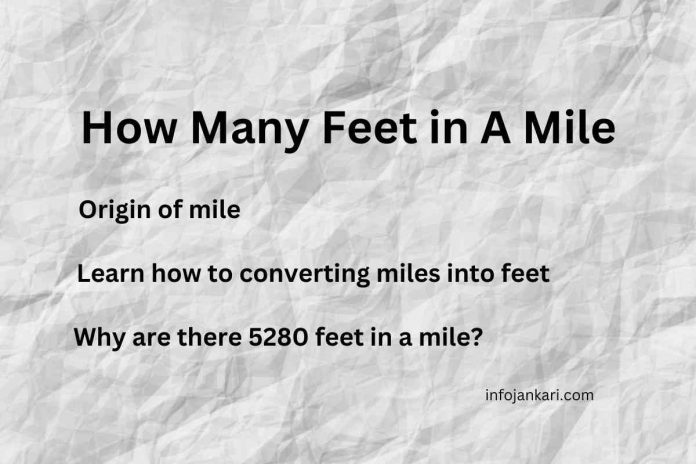Many more questions arise when we question how many feet in a mile. Various people thought it was a time-wasting question because finding this question on Google is relatively easy. The answer is 5280 feet in a mile. People often think it is a small matter to talk about, but it is a broader concept. This article will provide you with more brief information about miles and feet.
About Miles and feet
We use mile and its conversion in our daily life a lot, don’t we? Though it’s not intangible, we still do it. Even during our casual conversation, we use it as the main topic. When you take a short walk at night, you always discover the average number of miles you have covered. An athlete always talks about how many miles he has run or how many miles are still left to hide. And the more seats you release, the more you become conscious about the finish line.
Origin of mile
The word mile has been derived from the Latin Latin “mille”, which means a thousand. Latin has always been an origin hub of various things. Romans were quite exaggerated about organizing things in an orderly manner. Their contribution towards new things led to the invention of the mile and its conversion. Romans divided their 5000 Roman feet into a mile. Later every country started to measure their miles through their calculation. Roman mile was 1.852 km exactly, and the Italian mile was roughly 1.852 miles. The nautical mile was now 1.852 km exactly, while the Chinese mile was 500 m.
As time passed, another point of confusion arose, which stated that the mile was 52380 and not 5000. Before the 16th century, the British government was involved in this discussion and decided to measure miles with furlong. Then they started the calculation, which tells that the number of miles they measured with furlong is 660 feet. Later it is turned into 5280 feet.
Converting miles into feet
There are some methods of calculation which are provided on Google and in reference books. Yet some philosophers thought of doing the accounting on their own. Hence the conversion table of miles into feet is given below:
[wptb id=557]
Why are there 5280 feet in a mile?
In all places, the metric system is used officially to measure quantity. The Britishers decided to measure the per foot into 5280 miles. The Britishers acquired their calculation system from the Romans. At the same time, the Britishers were not ready to leave the concept of a furlong. It made a massive difference between the calculations of both countries. The British mile was equal to seven and a half furlongs, while the Roman mile was equal to 8 furlongs, later calculated as 5280 feet.
Numerical solving of how many feet in a mile
According to the British unit
1 mile = 8 furlongs
(a furlong is a calculation unit used in the generation of miles)
And,
1 furlong = 660 feet
Then
- I mile = ( 8 . 660 ) feet
- = 5280 feet
Conclusion
This article will conclude all the information about miles and feet, how to convert miles into feet, and the numerical formula for solving how many feet are in a mile.
FAQs
-
Why is 1 mile in 1 mile?
The word ‘mile’ has been derived from the word “ mille passus “, which means one thousand paces. While a mile was considered 1000 Roman strides, a stride was two paces. Layer in 1592, the English parliament confirmed one mile as 8 furlongs.
-
What is the difference between feet and miles?
There is no difference in the feet and mile as both are interrelated with each other because 5280 feet make up a mile.
-
How many feet is walking a mile?
There are around 2000 steps if you walk a mile. Therefore there are 5280 feet in a mile. If you want to calculate how many steps you walk daily, you can divide 5280 by your step length to measure it precisely.
-
How many steps in a day is normal?
The intermediate steps taken by a person are around 3000 – 4000 in a day. Or about 1 . 5 – 2 miles. Calculating the average steps can help you determine your baseline. Later you can increase the number of steps with time, which allows upgrading your speed and strength.
Also Read: Don’t Know Hindi Number and Counting in Hindi? Learn Now



